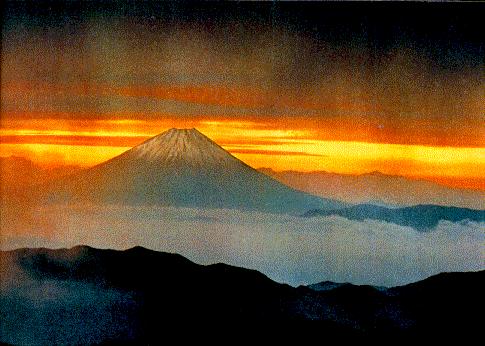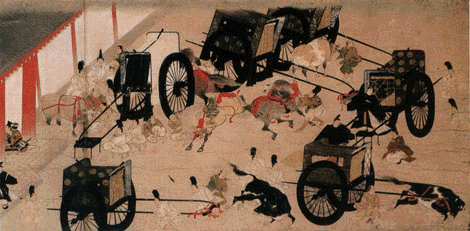|
Origins of the Samurai
The
Early Beginnings

The Japanese were thought to be
the descendents of migrants from Asia like China and Korea. Around 4500 B.C.,
the main inhabitants were mostly fishermen, hunters and farmers and this early
culture is known as the “Jomon” meaning cord pattern after the rope-like
designs on their pottery. The “Ainu”, a Caucasian race was believed to be
the first inhabitants of the islands and they still exist today in the
northernmost islands of Japan like Hokkaido. However, by 200 B.C. a major
cultural change occurred when the “Yaoyi” who were mostly farmers settled in
Japan. In appearance, they were very much like the modern Japanese.
As only about 20% of the land
is suitable for farming purposes there were frequent wars fought between
different clans. The chiefs of these clans were believed to be the ancestors of
the Japanese imperial family. This state of continued warfare gave rise to the
Samurai which means “one who serves.” According to legends, Jimmu Tenno,
also known as “The Divine Warrior” conquered the Kinki region all the way
from Kyushu and settled in Yamato thereby establishing the Yamato dynasty. Among
his descendents, Emperor Keiko was the first person accorded with the title of
“Shogun” which means “Barbarian-subduing General” and he had a son,
Prince Yamato who was to become the model for the future Samurai class.
According to the records,
Izanagi, the father of the deities has two children: Susano-o, the thunder god
and Amaterartsu, the sun goddess. After destroying a monstrous serpent, Susano-o
presented a sword from the serpent’s tail to Amateratsu and this sword
is known as the Ame no muarakumo, or “cloud-cluster sword.” This sword was
later given to Jimmu Tenno and was to form the first of the three “crown
jewels." The others were the mirror and the jewels. After the murder of his
elder brother, Yamato was dispatched to Kyushu but on the way he visited his
aunt at the Great Shrine of Ise and received the “cloud-cluster sword” from
her. Yamato’s adventures in the islands were to give rise to the image of the
“wondering swordsman” so stereotypical of the Samurai later.
The
Legend of the First Samurai - Yamato
There were many legends
surrounding the personality of Yamato. There was the story of how Yamato managed
to defeat a rebel chieftain using ninjutsu. Disguised as a woman with his sword
concealed under his robes, he managed to attack and kill the chieftain at the
banquet. Another story told of how Yamato was invited to a hunt but unknown to
him, his enemies had set fire to the grass with the intention of killing him.
Taking his sword, he managed to slash his way to safety through the burning
grass, only to be stung by the very serpent whose tail used to conceal the sword
the prince held in his hands. The sting proved fatal and Yamato came down with a
fever and died. After his death, he was transformed into a white bird and his
sword also known, as the Kusanagi became the sacred sword of Japan, forming one
of the three jewels. Later, the thirteenth-century epic, the Heike Monogatari,
“The Book of Swords” was to record attempts to steal the sacred sword.
However, the spirit of Yamato had prevented such attempts.

Later
Developments of the Emperorship and the Samurai Class
The coming of the Samurai
marked a distinct change in the military and political life of Japan. The
emperor system has changed from that of warring chieftains whose existence
depended on their martial arts capabilities to an ordered succession with
legitimate powers of emperors believed to be the descendents of the sun goddess,
Amateratsu. The emperors were believed to be divine and they were supported by a
bureaucracy, very much along the lines of the civil service in China, a
conscript army and at its center stood the imperial guards. Yet over the next
three centuries this very imperial system was to lead to its own demise. In
order to expand the rule of the emperors, many of the princes had left the
capital for the frontiers and this weakened the center and dispersed its
strength.
The Fujiwara clan through imperial consorts also dominated the court
and this was to cause much jealousy and resentment among the other powerful
clans such as the Taira to the west and Minamoto to the east and north. These
families’ military strength was unchallenged and although they were nominally
loyal to the emperor, the first loyalty of the Samurai in these families was to
the heads of the clans. They would follow the leadership of the heads of these
clans. The Taira and the Minamoto families also helped the emperor in his
expansion plans and against rebels to the throne. For their efforts, these
families were also richly rewarded.
This system has thus ensured the survival of
the emperorship this far. However, from the tenth century onwards, the emperors
had a tendency of abdicating young and passing the throne on to a minor. This
has freed the emperor from the enormous religious and ritual responsibilities as
king but this made the throne extremely vulnerable to manipulation. Although the
overthrow of the emperor is unthinkable, it is more importantly, not necessary.
Rather, the Taira and the Minamoto has tried to influence the successor to the
throne. This was the fuel that led to the outbreak of two wars the Hogen and the
Heiji, the predecessors of a much larger war known as the “Gempei” war
fought in the period 1180 to 1185. The key figure of this war was Minamoto
Yoshitsune from the Minamoto clan, whose success led to the establishment of his
brother, Yoritomo as Japan’s first Shogun. This episode was to mark the
beginning of the rule of the samurai class for the next eight hundred years of
Japanese history.

Time-LinE
660 B.C.— Jimmu Tenno became Japan’s first emperor
and setup the Yamato State
500 A.D.—Arrival of Buddhism as a powerful philosophy for
rulers and warriors and the domination of the Soga clan
645 A.D.—Taika Reforms
702 A.D.—Establishment of the Taiho law codes
794A.D.—Beginning of the Heian period
858 A.D.—Fujiwara family gained control of the imperial
court
935 A.D.—Revolt of Taira Masakado
1180-1185—Gempei War
1192—Yoritomo as first Shogun
Late 1200 A.D.—Invasion of the Mongols
1318 A.D.—The rise of the Ashikaga family
1467-77 A.D.—Sengoku Jidai (“The Age of the Country at
War”)
1560 A.D.—Unifying Japan
1592 A.D.—Invasion of Korea under Hideyoshi
1603 A.D.—Rise and rule of the Tokugawa family
1605 A.D.—Rise of Miyamoto Musashi
1615 A.D.—Drawing of the Buke Sho Hatto (Rules for
Martial Families)
1630 A.D.—Close Door Policy
1854 A.D.—Open Door Policy
1867 A.D.—Meiji Restoration
1868 A.D.—Five Articles Oath that dismantle the Samurai
class
1876 A.D.—Law declared that ended the wearing of swords.
The end of the Samurai class after more than a thousand years of existence
|